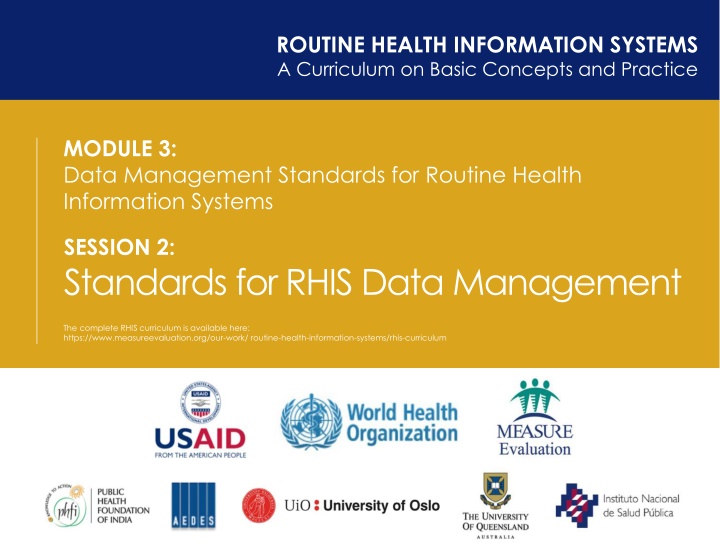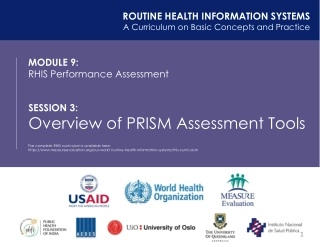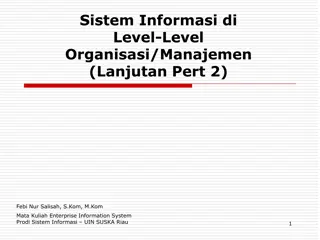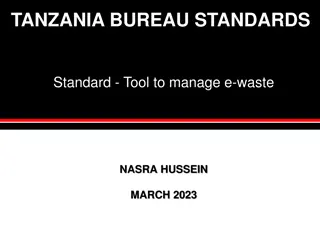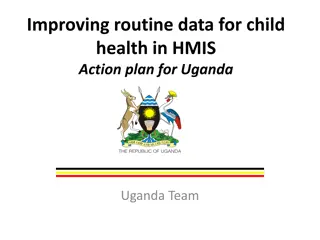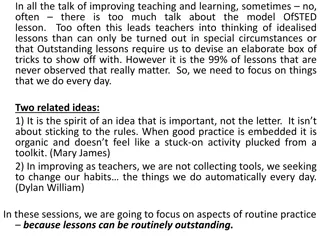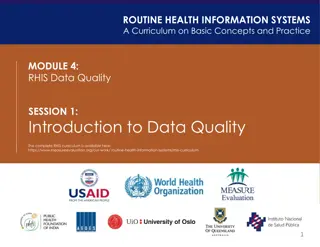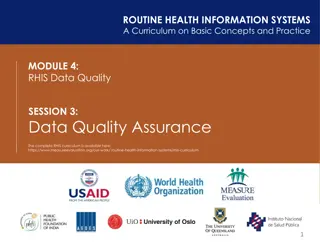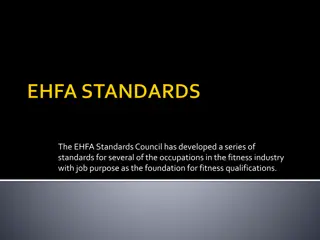Data Management Standards for Routine Health Information Systems
Explore the importance of standards in routine health information systems, including how they enhance functionality, identify weaknesses, and enable comparisons. Learn about harmonized standards and their role in improving RHIS performance. Discover when and how to apply standards in local systems effectively to enhance data quality and usage.
Download Presentation

Please find below an Image/Link to download the presentation.
The content on the website is provided AS IS for your information and personal use only. It may not be sold, licensed, or shared on other websites without obtaining consent from the author.If you encounter any issues during the download, it is possible that the publisher has removed the file from their server.
You are allowed to download the files provided on this website for personal or commercial use, subject to the condition that they are used lawfully. All files are the property of their respective owners.
The content on the website is provided AS IS for your information and personal use only. It may not be sold, licensed, or shared on other websites without obtaining consent from the author.
E N D
Presentation Transcript
ROUTINE HEALTH INFORMATION SYSTEMS A Curriculum on Basic Concepts and Practice MODULE 3: Data Management Standards for Routine Health Information Systems SESSION 2: Standards for RHIS Data Management The complete RHIS curriculum is available here: https://www.measureevaluation.org/our-work/ routine-health-information-systems/rhis-curriculum
Learning Objectives and Topics Covered Objectives Understand the importance of having standards for routine health information systems Understand when and how the standards should be applied to local systems Be familiar with the domains and subdomains of the standards Be familiar with the harmonized standards for routine health information systems Understand how the harmonized standards can improve RHIS performance (i.e., data quality and use) Topics Covered Domains and subdomains used to organize the standards Harmonized standards for routine health information systems
Importance of Standards Standards help ensure that important elements are present in the information system to ensure adequate functionality. Standards also help identify areas of weakness in information systems (by their absence). Standards permit comparisons with other information systems. Standards are based on experience and best practices (it works elsewhere; it can work here). Standards assist in the design of the system, acting like a blueprint for development. Standards permit accurate planning and costing of information systems, and effective management.
Sources for Standards MEASURE Evaluation RHIS data management standards guidelines. (South Africa workshop, 2012). WHO working document. Health facility information systems: Key components, attributes, and resources resource kit. (Glion meeting, 2014). IHP+ and WHO. Monitoring, evaluation and review of national health strategies: A country-led platform for information and accountability. 2011. Health Metrics Network. Assessing the national health information system: An assessment tool. Version 4.0. 2008.
When and how to apply the standards Standards are operationalized by comparing them to a local information system to see the extent of matching, or adherence to the standards Can be achieved in a workshop setting with information system stakeholders or as a field exercise with visits to health facilities Stakeholders discuss the standards and determine the extent to which a standard is met, or present, in the local system Results are used to prioritize system strengthening measures Should be conducted early in the planning cycle, prior to strategic planning and budgeting, so that required actions are built into the planning and budgeting. Can also be implemented as an ad hoc assessment during RHIS reform
Standards for Routine Health Information Systems 4 Domains Management & governance Data & decision support needs Data collection & processing Data analysis, dissemination, & use
Management & Governance 3 subdomains: Policies and planning Management Human resources
Management & Governance Subdomain: Policies & planning Legal and regulatory Planning Oversight and coordination Guidelines and policies
Management & Governance Subdomain: Management Standard operating procedures Leadership Feedback Supervision Assessments and use of assessments Master facility list
Management & Governance Subdomain: Human resources Workforce planning Training/capacity building
Data & Decision Support Needs 2 subdomains: Data needs Standards & system design
Data & Decision Support Needs Subdomain: Data needs Core indicators facility-based data on mortality and causes of death Community-based service data Surveillance
Data & Decision Support Needs Subdomain: Standards & system design Standards & data architecture System design
Data Collection & Processing 4 subdomains: Collection & management of individual client data Collection, management, & reporting of aggregated facility data Data quality assurance: see Module 4, Session 3 Information & communication technology: see Module 8
Data Collection & Processing Subdomain: Collection & management of individual client data Standard forms Training Data storage Reproduction
Data Collection & Processing Subdomain: Collection, management & reporting of aggregated facility data Data flow Guidelines Training Data disaggregation Data transfer
Data Collection & Processing Subdomain: Data quality assurance Planning Standards Roles and responsibilities Training Assessments Data quality checks Links to health sector planning Collaboration
Data Collection & Processing Subdomain: Information & communication technology (ICT) ICT framework ICT use Interoperability Training
Data Analysis, Dissemination, & Use 3 subdomains: Data analysis Information dissemination Data demand and use
Data Analysis, Dissemination, & Use Subdomain: Data analysis (see also Module 5) Data analysis Data cleaning Performance & progress reports Analysis tools Data sources Training
Data Analysis, Dissemination, & Use Subdomain: Information dissemination Information products Strategy Collaboration
Data Analysis, Dissemination, & Use Subdomain: Data demand & use Information culture Data demand Data use
Information Culture and Demand for Data The most visible outcome of a successful information culture is that information is in demand, valued as an important resource, and used at all levels to: Improve service delivery to clients Strengthen facility management Manage systems at each level
Exercise 1: Group Work on Rapid Assessment of RHIS Data Management Standards in Country X Instructions: Divide into 4 groups, each representing a level of the health system. Review the output from the rapid assessment of RHIS (ratings for individual RHIS data management standards and summary graphics). Identify problem areas and suggest interventions for improvement. You have 30 minutes for this task, then 5 minutes to present the results to the group.
ROUTINE HEALTH INFORMATION SYSTEMS A Curriculum on Basic Concepts and Practice This presentation was produced with the support of the United States Agency for International Development (USAID) under the terms of MEASURE Evaluation cooperative agreement AID-OAA-L-14-00004. MEASURE Evaluation is implemented by the Carolina Population Center, University of North Carolina at Chapel Hill in partnership with ICF International; John Snow, Inc.; Management Sciences for Health; Palladium; and Tulane University. The views expressed in this presentation do not necessarily reflect the views of USAID or the United States government.
